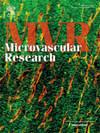PCSK9 inhibitor improved cardiac function after acute myocardial infarction in rats
IF 2.7
4区 医学
Q2 PERIPHERAL VASCULAR DISEASE
引用次数: 0
Abstract
Background
This study investigated the effects and possible mechanisms of Protein expression of protein convertase subtilisin/kexin type 9 (PCSK9) inhibitor evolocumab on cardiac function in rats with acute myocardial infarction (AMI).
Methods
The AMI model was established by ligating the left anterior descending coronary artery in rats. The mRNA expression of PCSK9 in myocardial tissues was detected by real-time fluorescent quantitative PCR (RT-qPCR). Echocardiography was used to examine the cardiac function indexes. Hematoxylin-eosin (HE) and Masson stainings were used to detect myocardial pathologic injury. 2,3,5-Triphenyltetrazolium chloride (TTC) staining was used to detect myocardial infarction area. Serum levels of low-density lipoprotein cholesterol (LDL-C), total cholesterol (TC), lactate dehydrogenase (LDH), creatine kinase isoenzymes (CK-MB), cardiac troponin T (cTnT), interleukin-1β (IL-1β), interleukin-17 (IL-17) and tumor necrosis factor-α (TNF-α) were detected by ELISA. CD31 and vascular endothelial growth factor (VEGF) positive expression was detected by immunohistochemistry. Protein expression levels of PCSK9, Bax, Bcl-2, cleaved-caspase3, receptor interacting protein kinase 1 (RIPK1), RIPK3, mixed lineage kinase domain-like (MLKL), and p-MLKL were detected in myocardial tissues by western blot.
Results
The mRNA level and protein expression of PCSK9 were significantly increased in AMI rats. PCSK9 inhibitor evolocumab reduced the levels of LDL-C and TC in serum, thereby improving dyslipidemia. And, evolocumab up-regulated the levels of left ventricular ejection fraction (LVEF) and left ventricular fractional shortening (LVFS), and down-regulated the levels of left ventricular end systolic diameter (LVESD), left ventricular end diastolic diameter (LVEDD), left ventricular end systolic volume (LVESV), and left ventricular end diastolic volume (LVEDV), which in turn improved cardiac function. In addition, evolocumab attenuated myocardial pathological injury, reduced myocardial infarction area, lowered the levels of LDH, CK-MB, cTnT, IL-1β, IL-17, and TNF-α, and inhibited apoptosis rate, down-regulated Bax, cleaved-caspase3, RIPK1, RIPK3, MLKL, p-MLKL expression, and up-regulated Bcl-2 protein expression, CD31 and VEGF positive expression.
Conclusion
The PCSK 9 inhibitor evolocumab improved cardiac function in AMI rats, and the mechanism may be related to the RIPK1/RIPK3/MLKL pathway.
PCSK9抑制剂改善大鼠急性心肌梗死后心功能。
背景:本研究探讨了蛋白转化酶subtilisin/kexin type 9 (PCSK9)抑制剂evolocumab蛋白表达对急性心肌梗死(AMI)大鼠心功能的影响及其可能机制。方法:结扎大鼠左冠状动脉前降支,建立急性心肌梗死模型。采用实时荧光定量PCR (RT-qPCR)检测PCSK9 mRNA在心肌组织中的表达。超声心动图检查心功能指标。苏木精-伊红(HE)染色和Masson染色检测心肌病理损伤。采用2,3,5-三苯四氮唑(TTC)染色检测心肌梗死面积。ELISA法检测血清低密度脂蛋白胆固醇(LDL-C)、总胆固醇(TC)、乳酸脱氢酶(LDH)、肌酸激酶同工酶(CK-MB)、心肌肌钙蛋白T (cTnT)、白细胞介素-1β (IL-1β)、白细胞介素-17 (IL-17)、肿瘤坏死因子-α (TNF-α)水平。免疫组化检测CD31和血管内皮生长因子(VEGF)阳性表达。western blot检测心肌组织中PCSK9、Bax、Bcl-2、cleaved-caspase3、受体相互作用蛋白激酶1 (RIPK1)、RIPK3、混合谱系激酶结构域样(MLKL)、p-MLKL的蛋白表达水平。结果:心肌梗死大鼠PCSK9 mRNA水平及蛋白表达显著升高。PCSK9抑制剂evolocumab降低血清LDL-C和TC水平,从而改善血脂异常。evolocumab上调左室射血分数(LVEF)和左室缩短分数(LVFS)水平,下调左室收缩末内径(LVESD)、左室舒张末内径(LVEDD)、左室收缩末容积(LVESV)和左室舒张末容积(LVEDV)水平,进而改善心功能。evolocumab可减轻心肌病理损伤,缩小心肌梗死面积,降低LDH、CK-MB、cTnT、IL-1β、IL-17、TNF-α水平,抑制凋亡率,下调Bax、cleaved-caspase3、RIPK1、RIPK3、MLKL、p-MLKL表达,上调Bcl-2蛋白表达、CD31、VEGF阳性表达。结论:pcsk9抑制剂evolocumab改善AMI大鼠心功能,其机制可能与RIPK1/RIPK3/MLKL通路有关。
本文章由计算机程序翻译,如有差异,请以英文原文为准。
求助全文
约1分钟内获得全文
求助全文
来源期刊

Microvascular research
医学-外周血管病
CiteScore
6.00
自引率
3.20%
发文量
158
审稿时长
43 days
期刊介绍:
Microvascular Research is dedicated to the dissemination of fundamental information related to the microvascular field. Full-length articles presenting the results of original research and brief communications are featured.
Research Areas include:
• Angiogenesis
• Biochemistry
• Bioengineering
• Biomathematics
• Biophysics
• Cancer
• Circulatory homeostasis
• Comparative physiology
• Drug delivery
• Neuropharmacology
• Microvascular pathology
• Rheology
• Tissue Engineering.
 求助内容:
求助内容: 应助结果提醒方式:
应助结果提醒方式:


